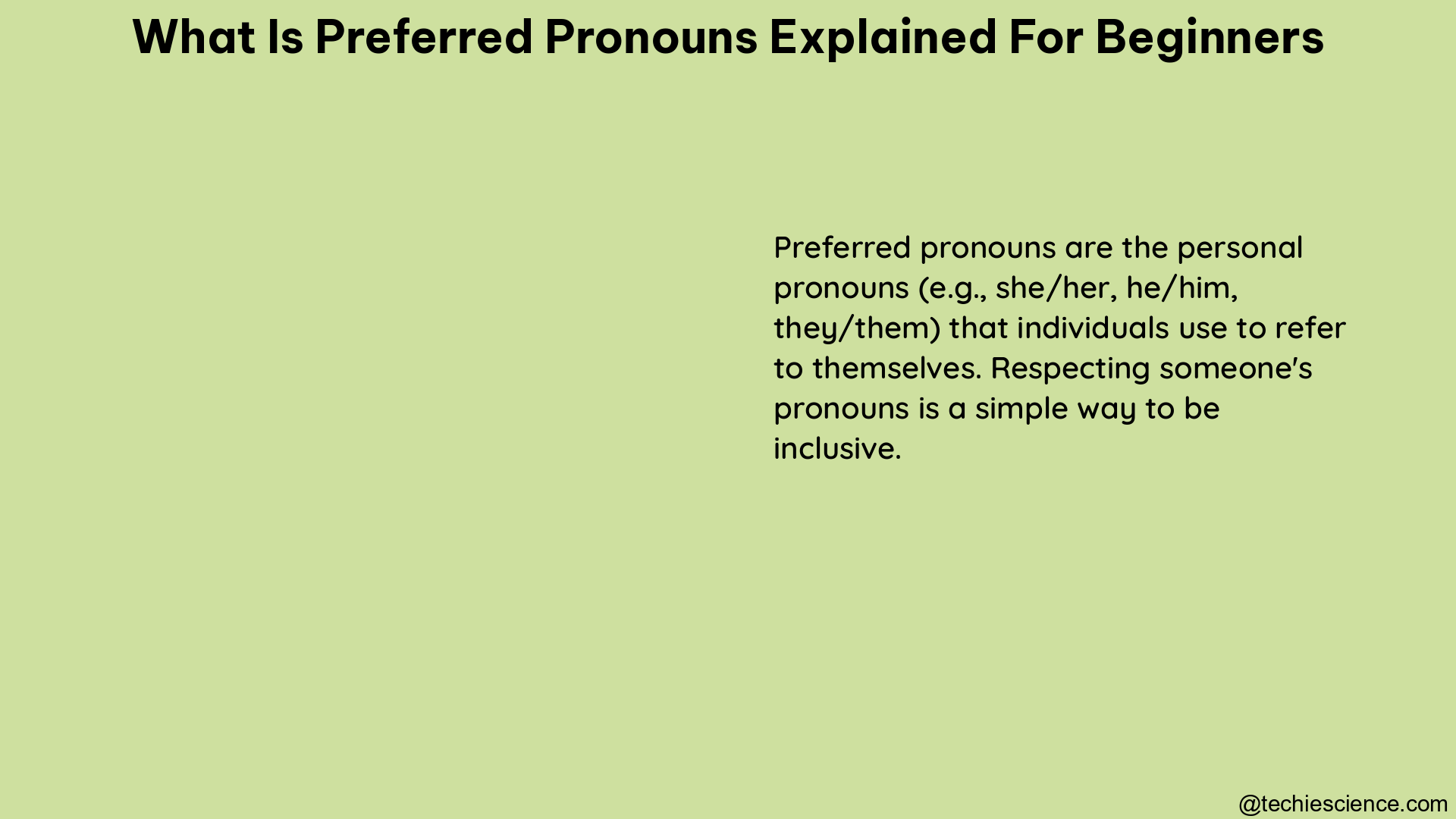Preferred pronouns are the set of pronouns that an individual wants others to use to reflect their own gender identity. This comprehensive guide will provide a detailed explanation of preferred pronouns for beginners, covering essential aspects such as understanding pronouns, their importance, common variations, and best practices for using them.
Understanding Pronouns
Pronouns are words used in place of a proper noun, such as someone’s name, to refer to them without using their name directly. Common examples of pronouns include “he,” “she,” “they,” and “ze.” These pronouns are an integral part of everyday language and can be a crucial way for individuals to express their gender identity.
Types of Pronouns
- Subject Pronouns: These pronouns are used as the subject of a sentence, such as “he,” “she,” and “they.”
- Object Pronouns: These pronouns are used as the object of a sentence, such as “him,” “her,” and “them.”
- Possessive Pronouns: These pronouns indicate ownership, such as “his,” “hers,” and “theirs.”
- Reflexive Pronouns: These pronouns refer back to the subject of the sentence, such as “himself,” “herself,” and “themselves.”
Understanding the different types of pronouns and their usage is crucial for effectively communicating and respecting an individual’s gender identity.
Importance of Preferred Pronouns

Using an individual’s preferred pronouns is essential for promoting equity, inclusion, and respect, particularly for transgender, non-binary, and genderqueer individuals. Misgendering, or using the wrong pronouns, can cause significant discomfort, stress, and anxiety for the person being referred to. In fact, research has shown that using correct pronouns and names can significantly reduce the risk of depression and suicide among transgender youth.
Common Pronouns and Their Variations
Here are some of the most common pronouns and their variations:
| Pronoun | Subjective | Objective | Possessive |
|---|---|---|---|
| He/Him/His | He went to the store. | I saw him at the park. | That is his car. |
| She/Her/Hers | She went to the store. | I saw her at the park. | That is her car. |
| They/Them/Theirs | They went to the store. | I saw them at the park. | That is their car. |
| Ze/Zir/Zirs | Ze went to the store. | I saw zir at the park. | That is zirs car. |
| Name Only | Alex went to the store. | I saw Alex at the park. | That is Alex’s car. |
It’s important to note that some individuals may use multiple pronouns, either interchangeably or in different contexts, and it’s essential to respect their preferences.
Asking for and Using Preferred Pronouns
When interacting with someone, it’s polite to ask about their preferred pronouns. You can simply ask, “What are your pronouns?” or “Which pronouns do you use?” It’s crucial to consistently use the pronouns the individual prefers, even if you make a mistake. If you do make a mistake, apologize briefly and move on, without dwelling on the error.
Multiple Pronouns and Contextual Usage
Some individuals may use multiple pronouns, either interchangeably or in different contexts. For example, someone might use “they/them” pronouns in professional settings and “he/him” pronouns in personal settings. It’s important to respect an individual’s preferences and use the appropriate pronouns in each context.
Role Modeling Trans Allyship
Using an individual’s preferred pronouns is a powerful way to role model trans allyship and create a more inclusive environment. You can do this by introducing yourself with your own name and pronouns, encouraging others to do the same, and consistently using the correct pronouns for everyone.
Key Takeaways for Beginners
- Understand the Importance of Preferred Pronouns: Using an individual’s correct pronouns is crucial for promoting equity, inclusion, and respect, particularly for transgender, non-binary, and genderqueer individuals.
- Learn Common Pronouns and Their Variations: Familiarize yourself with different pronouns, such as “he/him,” “she/her,” “they/them,” and “ze/zir,” and their corresponding subjective, objective, and possessive forms.
- Ask for and Use Preferred Pronouns: Respectfully ask individuals about their preferred pronouns and consistently use them, even if you make a mistake. Apologize briefly and move on.
- Be Prepared to Apologize and Learn: If you make a mistake in using someone’s preferred pronouns, apologize promptly and be open to learning and adapting to new concepts.
- Role Model Trans Allyship: Use preferred pronouns to create a trans-inclusive environment and encourage others to do the same, demonstrating your commitment to supporting the LGBTQ+ community.
By understanding and applying these principles, you can become a more informed and inclusive communicator, contributing to a more equitable and welcoming environment for all.
References
- LGBT Life Center. (n.d.). Understanding Pronouns. Retrieved from https://lgbtlifecenter.org/pronouns/
- Wikipedia. (n.d.). Preferred gender pronoun. Retrieved from https://en.wikipedia.org/wiki/Preferred_gender_pronoun
- Stonewall. (2022). A beginner’s guide to pronouns and using pronouns in the workplace. Retrieved from https://www.stonewall.org.uk/workplace-trans-inclusion-hub/beginner%E2%80%99s-guide-pronouns-and-using-pronouns-workplace
- NPR. (2021). A Guide to Understanding Gender Identity and Pronouns. Retrieved from https://www.npr.org/2021/06/02/996319297/gender-identity-pronouns-expression-guide-lgbtq
- Vassar College. (n.d.). Understanding Gender Pronouns. Retrieved from https://offices.vassar.edu/lgbtq/trans-non-binary-resources/gender-pronouns/

The lambdageeks.com Core SME Team is a group of experienced subject matter experts from diverse scientific and technical fields including Physics, Chemistry, Technology,Electronics & Electrical Engineering, Automotive, Mechanical Engineering. Our team collaborates to create high-quality, well-researched articles on a wide range of science and technology topics for the lambdageeks.com website.
All Our Senior SME are having more than 7 Years of experience in the respective fields . They are either Working Industry Professionals or assocaited With different Universities. Refer Our Authors Page to get to know About our Core SMEs.